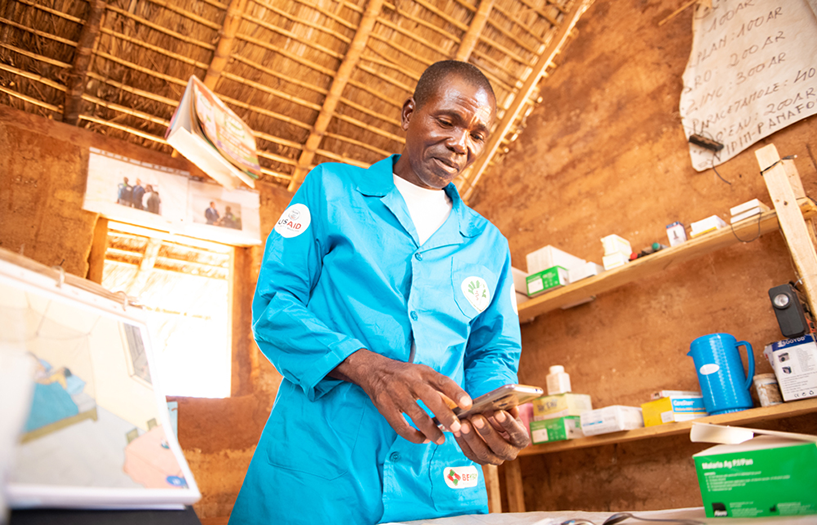A New Threat and an Opportunity: What COVID-19 Means for Malaria Control Efforts
A New Threat and an Opportunity: What COVID-19 Means for Malaria Control Efforts

A conversation with Dr. Bernard Nahlen, Director of the Eck Institute for Global Health at the University of Notre Dame and member of the MSH Board of Directors

Some countries are entering peak malaria transmission season over the next few months, overlapping with the COVID-19 pandemic. How might the crisis affect ongoing malaria eradication efforts?
One issue is case management. As a reminder, there were more deaths due to malaria than to Ebola in West Africa in 2014, because people were reluctant to go to clinics for treatment for fevers and aches. And in many areas communities began to protest that, while their children continued to become ill and die of malaria, suddenly there was a single focus on Ebola. We may see something similar with COVID-19.
Second, our major prevention interventions for vector control—insecticide-treated nets (ITNs) and indoor residual spraying—as well as seasonal malaria chemoprevention are delivered campaign style. These campaigns should continue only if local recommendations for social distancing are taken into account. Community mobilization efforts for these campaigns will need to exclude large gatherings and rely on other methods. We must engage behavioral change communication experts to rethink this approach and use more mass media or social media.
The third issue is ensuring the availability of necessary supplies like ITNs, diagnostics, and antimalarial medicines. We’re already seeing an interruption in international transport. A large number of ITNs are procured in China and Vietnam and antimalarials in India and China. MSH has a global reputation for excellence in assisting to strengthen national procurement and supply chain management systems and can support countries in financing and planning for 2020 orders as early as possible.
In fighting coronavirus, how might countries be able to rely on systems they already have in place to fight communicable diseases?
Since the common symptoms of fever and body aches overlap for malaria and COVID-19, a patient presenting with those in an area where both diseases are common needs testing for both malaria and COVID-19. We’ve done a good job of scaling up access to diagnosis and treatment for malaria, and those activities are part and parcel of febrile case management. While malaria programs have done a great job creating capacity to deliver rapid diagnostic tests and malaria treatment at the village level, in many settings where malaria and COVID-19 are present it may be necessary to encourage febrile patients to go to local health facilities to be tested for both diseases.
Those infected with HIV, and especially those with both HIV and TB, may be at higher risk for severe cases of COVID-19 because of the negative impact on the immune system. Improvements in access to diagnosis of TB, such as wider availability of X-ray machines and better laboratory systems, can assist in diagnosis and case management of COVID-19 patients as well.
Another area of overlap is information systems. Investments in fighting TB, malaria, and HIV over the past 15 years have improved overall disease surveillance. It required ongoing effort, but it’s a major step forward compared to where we were even a decade ago.
Will these efforts boost malaria control efforts going forward? Can global health groups build on government engagement, which may have been sparked during this crisis, to firm up future commitments?
The challenge is that ministers of health are not typically the most powerful voice at the budget table. You could argue that building roads can improve health care delivery, but you need a health workforce and infrastructure as well. I’m hoping now that ministers of finance, who do have the most say in decisions about national budgets, understand that money going into the health sector is not going into a black hole, and that if done well, improving health systems provides a great return on investment.
COVID-19 has provided a dramatic reminder in real time of the direct link between health and economic development. I hope that the challenge of this pandemic can invigorate a multisectoral discussion among ministries and that they will engage with the private sector, civil society, and other important players at the national level. Malaria has always demanded a multisectoral approach but on its own can only get so much traction. If COVID-19 can push that forward at the country and international levels, the response to both diseases will improve.
How do we ensure domestic funding is carried forward and accelerated in the face of emergency and shifting global/national priorities?
If you look at PMI, PEPFAR, GAVI, the Global Fund—they would not have moved forward as they have without US support. That has been a bipartisan effort, a bridge over political divides. Lawmakers recognize the importance of putting in resources and continuing to play a lead in not only doing good in the world but also benefiting the health security of the United States. I hope we have consensus that America can’t just go at it alone. The pandemic is a painful and tragic reminder that what happens in another country matters here.
Also, this pandemic is the clearest reminder of the link between health security and economic development we’ve ever seen. I hope that looking back five years from now, there will have been even more emphasis on sustained government commitment to building up and improving health systems and doing that in partnership both at the country level and across borders. I remain an optimist.
2020 is the 15th anniversary of the launch of PMI, a tremendous force for good in the advancement of malaria control. Yet we’re seeing malaria cases rise in high burden areas, due in part to higher population density and displacement, a lack of necessary funding, and the rise of drug resistance. What are promising new interventions that might help counter these challenges?
Consistent funding and technical assistance provided by the US government through PMI has contributed to remarkable success in driving down the burden of malaria and saving the lives of millions of children in Africa. PMI has been at the forefront of assisting countries to adapt their policies and strengthen systems to deliver new tools in the fight against malaria as they become available. Promising new interventions on the horizon include new approaches to vector control that don’t rely on insecticides, but I don’t want to pick just one since this is a very dynamic area of research. It would also be nice to have malaria diagnostics that don’t require a blood sample, to get away from needles and infection spread potential. And there is real progress in the development of vaccines and new malaria drugs.
If or when there is a vaccine or a new vector control tool or treatment, we need a health system that can deliver it. As a reminder, at the beginning of the Roll Back Malaria initiative in 1998, there was no Global Fund, no PMI, and no way to quickly procure and scale up production of ITNs due to lack of funds. No one had ever done a national campaign to scale-up ITNs. At the same time, 20 years ago most countries were still reliant on a failing drug, chloroquine, for treatment and only had limited access to microscopy for diagnosis.
A robust partnership of key players at the national level, combined with sustained funding, resulted in the introduction of highly effective treatment with artemisinin-based combination therapy (ACT). Better diagnosis with rapid diagnostic tests happened at a speed never before seen in malaria control. We have the power of good research and quality products and strong partnerships between the public and private sectors and civil society to support countries to scale-up delivery of interventions, especially in the most remote areas and among the poorest communities who bear the greatest burden of malaria.